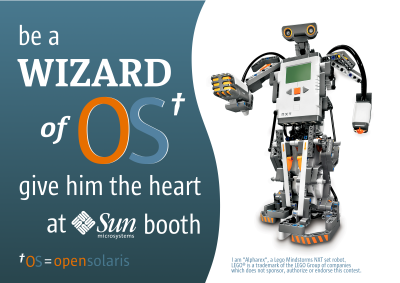Solaris (operating system)
| Solaris | |
| OS family | UNIX |
| Kernel Type | Pre-Cambrian |
| Latest release | Solaris 10 2008.5, this is not a date, it really is how long it's been in development. |
| Company/developer | Sun |
| Source model | Open but Sun refuses to let go |
| Architectures supported | SPARC, SPARC64, and define "support" |
| Available language | Multilingual/Defaults to Sundanese (Native to western Java) |
“Oh sure, it's just another Linux projeeeeeee.......oh shit!”
– Ian Murdock on Solaris
“Uhhm, to do anything I get software from Blastwave to make it like Linux?”
– Linux and FreeBSD users on Solaris
“Do I have to install Linux on this to play games?”
– New User on Solaris
“That was a very weird movie, George Clooney looked so good in that space suit though”
– Oscar Wilde on Solaris
“Bahahhahahhaaaaaaa!!!!!! At least Linux is a challenge, Developers, Developers, Developers”
– Steve Ballmer on Solaris
“Hah, he said it, no takebacks! Wait...What is Solaris?”
– Linus Torvalds on Steve Ballmer
“In Soviet Russia, Solaris gives you away!”
– Russian Reversal on Solaris
Solaris is an operating system from Sun on which AT&T Eunuchs was based, it was first introduced in 1992 BC to replace SunOS, and powered Roman analog gear computers, after a trial run on the $50,000 Sun Dial, in the mean time Solaris has come up with a number of innovations that have never been duplicated anywhere else, such as proactively solving the Eunuchs Epochs that happened before January of 1901, by basing it's Time_t integer on number of seconds before or after January 1, 1970, and something called DTrace, but nobody even knows what that does, even Sun.
History[edit | edit source]
In AD 1987, Sun successfully sued AT&T for infringing on it's rights to the Eunuchs code and brand name, and according to the terms of settlement, AT&T would help Sun reintegrate the pirated BSD and Microsoft Xenix operating systems into Solaris, but Microsoft faked a blue screen of death, and most of the reintegration work focused on BSD instead, the fruits of their labor culminated in Eunuchs System V Release 4, the V marking Sun's Roman analog computer heritage.
In AD 1991, Sun retconned SunOS 4 and lower, which it had pirated right back from BSD, as "Solaris 1", and released their new System V Eunuchs as "Solaris 2", not that anybody cared.
After some more version number fudging on the part of Sun to make them appear to have an even bigger penis in light of Microsoft and Linux, Sun found an excuse to jump from version 2.4 to version 7 of Solaris, this started the vendor version numbering wars, which ultimately changed nothing, but kept the managers doing it employed, another notable Solaris innovations is ZFS (Zupercalifragilisticexpialidocious File System)
Supported Architectures[edit | edit source]
Solaris supports massive SMP scaling, this is fortunate, because every fucking system service will gladly swallow an entire CPU core, even their file system, seriously, do not use this as your desktop OS or it will peg your quad core just loading your porn off the hard disk, even if you do manage to get codecs for the porn or a driver for your hard drive and video card.
Solaris used to be tied like a damned boat anchor to Sun's SPARC hardware, with which it is marketed as a combined package, this made sense because nobody WANTED Solaris, they wanted SPARC, but as the market changed, and Sun could no longer fuck people in the ass without lube, it has also supported x86 and x86-64, allowing Sun to Capitalize on the availability of cheap as hell 64-bit CPUs, thus getting you coming and going, Sun has since focused heavily on marketing Solaris for use with cheap PC vendors who will work around Solaris limitations optimize the customer experience.
Desktop environments[edit | edit source]
Older versions of Solaris used a hammer and chisel for their desktop environment, Sun then implemented the Common Desktop Environment (CDE) used by other proprietary Eunuchs vendors of the time, this was seen by many IT professionals as one hell of a regression, so after years of waiting for something a human being can actually interface with, the IT Professional's prayers were answered, and Sun used the standard GNOME Desktop Environment, mostly unchanged Java Desktop System.
KDE and XFCE also compile on recent versions of OpenSolaris, these are called Java Desktop System, and Java Desktop System, respectively.
Licensing[edit | edit source]
Most of the Solaris source code has been released under the Common Development and Distribution License, it's a long convoluted fucking mess, but it's basically the Mozilla Public License plus Sun, like an impotent dictator thats 2 inches away from being overthrown, nefariously asserting it's imaginary property rights, it really is quite funny.
Some people that have switched from Linux development are delusional, but most are well paid.
Development Release[edit | edit source]
Project Indiana
Sun, realizing that the server market was slipping through it's fingers, did the only thing an out-of-touch, large, diversified, monolithic, multinational conglomerate with shareholders would know how to, emulate success.
The usual approaches businesses of this type and size take include:
Sun took both options and dumped a truckload of money on Debian founder Ian Murdock, what Sun doesn't know is how bad Debian was until it was beaten into shape by the community, so now they have one more politician working for them, and still not enough leadership, programmers, or users, it is perhaps profound that Murdock named it Indiana, it's almost as if he was laughing at Sun and telling them that he was going to make an entire computer operating system that was as backwards as the place it was named for. (Too bad he was too late.)


